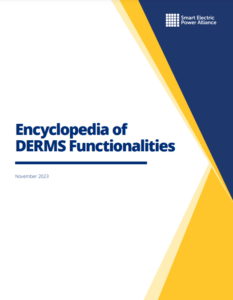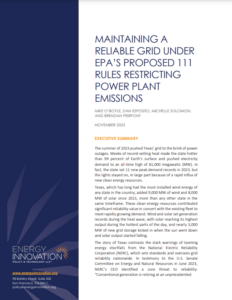The OurEnergyLibrary aggregates and indexes publicly available fact sheets, journal articles, reports, studies, and other publications on U.S. energy topics. It is updated every week to include the most recent energy resources from academia, government, industry, non-profits, think tanks, and trade associations. Suggest a resource by emailing us at info@ourenergypolicy.org.
Resource Library
The World Energy Outlook 2023 provides in-depth analysis and strategic insights into every aspect of the global energy system. Against a backdrop of geopolitical tensions and fragile energy markets, this year’s report explores how structural shifts in economies and in energy use are shifting the way that the world meets rising demand for energy.
This Outlook assesses the evolving nature of energy security fifty years after the foundation of the IEA. It also examines what needs to happen at the COP28 climate conference in Dubai to keep the door open for the 1.5 °C goal. And, as it does every …
View Full ResourceAs countries pursue decarbonization goals, the rapid expansion of transmission capacity for renewable energy (RE) integration poses a significant challenge due to hurdles such as permitting and cost allocation. However, we find that large-scale reconductoring with advanced composite-core conductors can cost-effectively double transmission capacity within existing right-of-way (ROW), with limited additional permitting. This strategy unlocks a high availability of increasingly economically viable RE resources in close proximity to the existing network. We implement reconductoring in a model of the United States power system, showing that the consideration of reconductoring enables four times more transmission build-out by 2035 – representing over …
View Full ResourceThis effort improves the effectiveness and reduce uncertainty in Operations and Management (O&M) cost through four primary objectives/tasks: 1) institutionalize standards for reliability and availability reporting for large PV power plants; 2) bridge systemic O&M knowledge gaps around important topics affecting O&M; 3) characterize systemic failure modes and patterns and accelerate O&M experiential learning cycles using field data; and 4) Establish a baseline understanding of UPVS O&M Cost drivers.
Key results associated with this effort include production of a technical specification and report to the IEC committee, published case studies on O&M topics, conduct training, and characterize field data for …
Many environmental hazards produce health effects that take years to arise, but quasi-experimental studies typically measure outcomes and treatment over short time periods. We develop a new approach to overcome this challenge and use it to gauge the effect of exposure to air pollution on US life expectancy. Using changes in wind direction as an instrument for daily sulfur dioxide levels, we first characterize the short-run mortality effects of acute exposure during the time period 1972-1988. Exposure causes two distinct mortality patterns: a short-run mortality displacement effect, and a persistent accelerated aging effect. We then incorporate our estimates into a …
View Full ResourceRadioactive sources are commonly used for medical, industrial, and research purposes. However, these materials can be harmful and dangerous, if used improperly.
NRC and states to which it has delegated authority issue licenses for the possession and use of radioactive sources. These entities regulate disposal facilities that can accept certain sources and waste. Several federal programs support disposal of some sources, but some licensees still hold onto sources beyond their useful lives. Doing so increases the risk that sources could be orphaned and misused.
House Report 117-118 accompanying a bill for the National Defense Authorization Act for Fiscal Year 2022 …
RMI’s Applied Innovation Roadmap (AIR) provides a comprehensive, objective, and action-oriented perspective on how to best advance the technical readiness of 32 carbon dioxide removal (CDR) approaches this decade. The roadmap is designed for the global ecosystem of policymakers, public and private sector funders, technology developers, and research organizations that shape research, development, and demonstration (RD&D) activity. It provides complete transparency about the risks and opportunities of all known CDR approaches, and offers visibility and guidance on research, development, and demonstration needs and opportunities.
RMI intends for this roadmap to unlock a larger volume of funding that is coordinated and …
View Full ResourceThe distributed energy resource landscape is continuously expanding and broadening its reach. Technology that started as mainly niche rooftop solar installations has now expanded to include heat pump water heaters, intelligent thermostats, battery energy storage, intelligent vehicle charging, and other devices. Increasingly, utilities have opted to deploy a software solution that can interact with these grid-edge technologies called a distributed energy resource management system (DERMS).
Evaluating, selecting, and justifying DERMS remains challenging due to the high cost of the solution and complexities in integrations, cybersecurity, and implementation timelines. SEPA and a task force of 12 utilities used insights from 11 …
View Full ResourceCutting steel sector emissions is essential to limiting global warming to 1.5°C by 2050, and to accomplish this goal, decarbonization and economic strategies must include ambitious action in the Great Lakes. To help state policymakers, economic development offices, and regional NGOs support the Great Lakes steel industry transition, RMI has produced a series of state-specific memos that outline:
– The scale and enabling environment required for near-zero-emissions steel production
– Gaps and opportunities for policymakers and other state-level actors to support via policy and infrastructure projects
– Specific site outlook and recommendations at the facility level…
As key consumers of steel, cement, and other major construction materials, US state governments play an influential role in reducing climate-warming emissions from manufacturing and construction projects. These emissions are commonly known as embodied carbon — the millions of tons of greenhouse gas emissions created from material extraction, manufacturing, transport, construction, and disposal. In Buy Clean and Beyond: A Guide to Reaching Net-Zero Embodied Carbon in State-Owned Building Projects, RMI provides a comprehensive framework that state agencies and policymakers can use to reach net-zero embodied carbon emissions from public building projects.…
View Full ResourceThe Environmental Protection Agency’s (EPA) proposed “111 rules” restricting greenhouse gas emissions have sparked debate about whether they will create consequences that threaten grid reliability. However, rather than raising new concerns, these objections principally raise issues already facing the power sector. The Inflation Reduction Act has made low-carbon resources including wind, solar, and storage the cheapest new resources in the U.S., but system planners worry we cannot add them fast enough to make up for fossil retirements. New Energy Innovation research details the potential impacts of the EPA rules, investigates their effects on the electricity system, and evaluates potential changes …
View Full Resource








